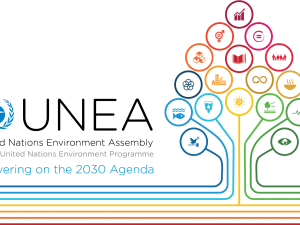Legacy of waste from Great East Japan earthquake underscores need for urgent action on marine litter
Discussion details

Five years ago, a 30 foot wall of cold, black water crashed into the east coast of Japan. The tsunami's raging waters, which were triggered by a 9.0 earthquake, killed nearly 16,000 people, wiped out entire towns and villages and caused one of the world's worst nuclear disasters.
The power of the tsunami was so strong that the debris washed into the ocean included fishing boats, entire houses, cars and everything in between, totaling more than one million tonnes of wreckage. Within days of the Great East Japan Earthquake, the patches of disaster debris floating off Japan's coast were so large that they were visible on satellite images.
Swept along by large circular currents and winds, the floating debris has since crossed the Pacific Ocean, hitting coastlines in America and Canada - everything from refrigerators to sports balls. Much of the debris has gathered in floating islands of waste 25 kilometres offshore, waiting for a storm surge to wash the debris ashore.
As the world commemorates the fifth anniversary of the earthquake, the tsunami and the resulting Fukushima nuclear disaster, the journey taken by the debris from the tragedy underscores the immense environmental problem that marine waste and litter poses.
The floating islands of debris, which have crossed the Pacific Ocean, also highlight the importance of transboundary, global collaboration in preventing and reducing the harmful impact of marine litter. Marine litter that comes from land-based as well as sea-based sources can harm ecosystems, human health and economies.
The issue is too big for any one country, organization or agency to address alone. Hosted by the United Nations Environment Programme (UNEP), the Global Partnership on Marine Litter brings together inter-governmental agencies, civil society, governments, the private sector and academia to prevent and reduce the impact of marine litter.

UNEA
The urgency of addressing marine litter was recognized in 2014 at the First UN Environment Assembly (UNEA-1), the highest-level decision-making body on the environment. The marine litter resolution that passed at UNEA-1 asked UNEP to undertake a study on marine plastic debris and microplastics and to come up with urgent action plans on how to tackle the problem.
The study will be released ahead of the next meeting of UNEA, which takes place in Nairobi in May. It will be used to inform the Assembly's debate about how the world should respond to the problem. UNEA-2 itself will also focus on this issue and a side event specifically on marine litter and microplastics will be organized at the next Assembly.
More information on UNEA-2 can be found on this website.
UNEP has set up several initiatives to tackle the issue of marine litter and micrplastics in the oceans. One example is the UNEP/MAP Regional Plan on Marine Litter Management in the Mediterranean. More information about the plan and its partners can be found here.
Log in with your EU Login account to post or comment on the platform.